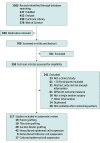Surgical Interventions for Patients With Vitiligo: A Systematic Review and Meta-analysis
- PMID: 33595599
- PMCID: PMC7890456
- DOI: 10.1001/jamadermatol.2020.5756
Surgical Interventions for Patients With Vitiligo: A Systematic Review and Meta-analysis
Abstract
Importance: Surgical interventions are a key part of the therapeutic arsenal, especially in refractory and stable vitiligo. Comparison of treatment outcomes between the different surgical procedures and their respective adverse effects has not been adequately studied.
Objective: To investigate the reported treatment response following different surgical modalities in patients with vitiligo.
Data sources: A comprehensive search of the MEDLINE, Embase, Web of Science, and Cochrane Library databases from the date of database inception to April 18, 2020, was conducted. The key search terms used were vitiligo, surgery, autologous, transplantation, punch, suction blister, and graft.
Study selection: Of 1365 studies initially identified, the full texts of 358 articles were assessed for eligibility. A total of 117 studies were identified in which punch grafting (n = 19), thin skin grafting (n = 10), suction blister grafting (n = 29), noncultured epidermal cell suspension (n = 45), follicular cell suspension (n = 9), and cultured epidermal cell suspension (n = 17) were used.
Data extraction and synthesis: Three reviewers independently extracted data on study design, patients, intervention characteristics, and outcomes. Random effects meta-analyses using generic inverse-variance weighting were performed.
Main outcomes and measures: The primary outcomes were the rates of greater than 90%, 75%, and 50% repigmentation response. These rates were calculated by dividing the number of participants in an individual study who showed the corresponding repigmentation by the total number of participants who completed the study. The secondary outcomes were the factors associated with treatment response to the surgical intervention.
Results: Among the 117 unique studies and 8776 unique patients included in the analysis, rate of repigmentation of greater than 90% for surgical interventions was 52.69% (95% CI, 46.87%-58.50%) and 45.76% (95% CI, 30.67%-60.85%) for punch grafting, 72.08% (95% CI, 54.26%-89.89%) for thin skin grafting, 61.68% (95% CI, 47.44%-75.92%) for suction blister grafting, 47.51% (95% CI, 37.00%-58.03%) for noncultured epidermal cell suspension, 36.24% (95% CI, 18.92%-53.57%) for noncultured follicular cell suspension, and 56.82% (95% CI, 48.93%-64.71%) for cultured epidermal cell suspension. The rate of repigmentation of greater than 50% after any surgical intervention was 81.01% (95% CI, 78.18%-83.84%). In meta-regression analyses, the treatment response was associated with patient age (estimated slope, -1.1418), subtype of vitiligo (estimated slope, 0.3047), and anatomical sites (estimated slope, -0.4050).
Conclusions and relevance: The findings of this systematic review and meta-analysis suggest that surgical intervention can be an effective option for refractory stable vitiligo. An appropriate procedure should be recommended based on patient age, site and size of the lesion, and costs.
Conflict of interest statement
Figures
References
Publication types
MeSH terms
LinkOut - more resources
Full Text Sources
Other Literature Sources
Medical
Miscellaneous



